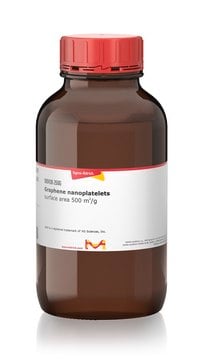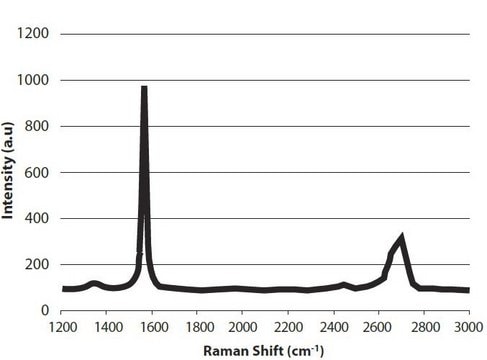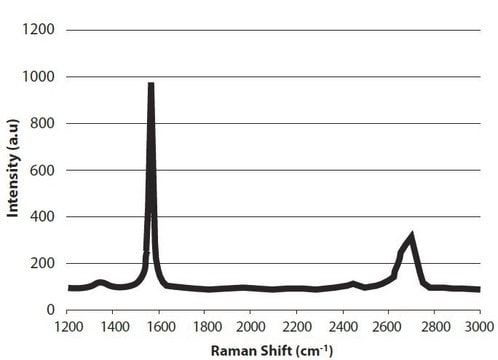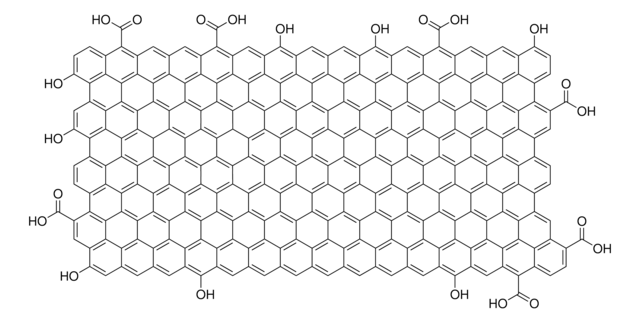900413
Graphene nanoplatelets
25 μm particle size
About This Item
Polecane produkty
opis
residual acid content: < 0.5 wt%
Poziom jakości
Postać
powder
skład
oxygen content, <1%
powierzchnia
120-150 m2/g
grubość
6-8 nm , average
wielkość cząstki
25 μm
gęstość nasypowa
0.03‑0.1 g/cm3
InChI
1S/C
Klucz InChI
OKTJSMMVPCPJKN-UHFFFAOYSA-N
Szukasz podobnych produktów? Odwiedź Przewodnik dotyczący porównywania produktów
Powiązane kategorie
Opis ogólny
- xGnP® graphene nanoplatelets are unique nanoparticles consisting of short stacks of graphene sheets having a platelet shape.
- The unique size and platelet morphology of xGnP® graphene nanoplatelets makes these particles especially effective at providing barrier properties, while their pure graphitic composition makes them excellent electrical and thermal conductors. xGnP® graphene nanoplatelets can improve mechanical properties such as stiffness, strength, and surface hardness of the matrix material.
- xGnP® graphene nanoplatelets are compatible with almost all polymers, and can be an active ingredient in inks or coatings as well as an excellent additive to plastics of all types. The unique manufacturing processes are non-oxidizing, so material has a pristine graphitic surface of sp2 carbon molecules that makes it especially suitable for applications requiring high electrical or thermal conductivity.
- Grade M particles have an average thickness of approximately 6-8 nanometers and a typical surface area of 120 to 150 m2/g. Grade M is available with average particle diameters of 5, 15 or 25 microns.
Zastosowanie
- Ultracapacitor electrodes.
- Anode materials for lithium-ion batteries.
- Conductive additive for battery electrodes.
- Electrically conductive inks.
- Thermally conductive films and coatings.
- Additive for lightweight composites.
- Films or coatings for EMI shielding.
- Substrate for chemical and biochemical sensors.
- Barrier material for packaging.
- Additive for super-strong concrete.
- Additive for metal-matrix composites.
Inne uwagi
Informacje prawne
Kod klasy składowania
11 - Combustible Solids
Klasa zagrożenia wodnego (WGK)
WGK 1
Temperatura zapłonu (°F)
Not applicable
Temperatura zapłonu (°C)
Not applicable
Certyfikaty analizy (CoA)
Poszukaj Certyfikaty analizy (CoA), wpisując numer partii/serii produktów. Numery serii i partii można znaleźć na etykiecie produktu po słowach „seria” lub „partia”.
Masz już ten produkt?
Dokumenty związane z niedawno zakupionymi produktami zostały zamieszczone w Bibliotece dokumentów.
Klienci oglądali również te produkty
Produkty
Advances in scalable synthesis and processing of two-dimensional materials
Nasz zespół naukowców ma doświadczenie we wszystkich obszarach badań, w tym w naukach przyrodniczych, materiałoznawstwie, syntezie chemicznej, chromatografii, analityce i wielu innych dziedzinach.
Skontaktuj się z zespołem ds. pomocy technicznej







